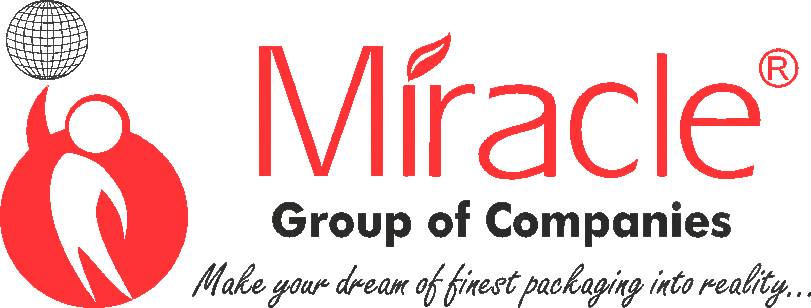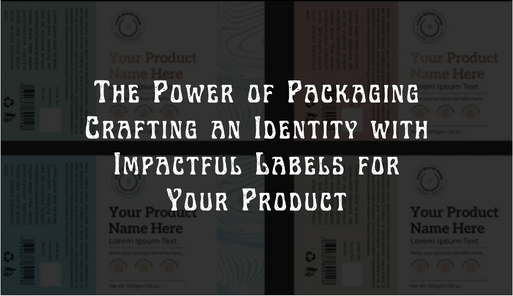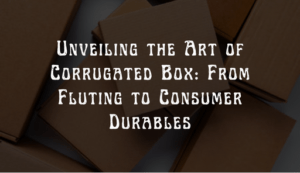In the dynamic landscape of the consumer market, packaging serves as the face of a product. It’s not just a protective layer; it’s a powerful tool for creating a lasting impression. The packaging identity is the unique visual and tactile representation that distinguishes a product from the myriad of options available to consumers. In the world of product presentation, the concept of packaging identity revolves around the impactful use of labels for packaging. These labels serve as the visual storytellers, uniquely conveying a product’s essence, brand values, and essential information. Through the strategic amalgamation of design elements and consumer psychology, labels become the forefront of a product’s identity, making an immediate and lasting impression on consumers.
Importance of Labels
Labels play a pivotal role in packaging identity. They are the storytellers, conveying essential information about the product, its ingredients, and its brand. Custom labels for packaging act as a visual ambassador, communicating the brand’s values and establishing a connection with the consumer. They are indispensable in the world of packaging, serving multiple crucial roles:
- Informational Hub: Labels convey vital details about the product, including ingredients, usage instructions, and safety information.
- Brand Identity: Custom labels establish a visual representation of the brand, fostering recognition and loyalty.
- Legal Compliance: Labels ensure adherence to regulatory requirements, preventing legal complications and building consumer trust.
- Differentiation: Unique labels set products apart on crowded shelves, aiding in consumer decision-making.
- Consumer Communication: Labels communicate a brand’s values, story, and benefits, fostering a connection with the consumer.
Design Elements for Impactful Labels
Crafting impactful labels involves a thoughtful combination of design elements. Colors, typography, imagery, and shape contribute to creating a visually appealing and memorable label. Understanding the target audience and aligning the design with the brand message is key to leaving a lasting impression.
- Color Palette: Choose colors that evoke the desired emotions and align with the brand’s identity. Consider color psychology to influence consumer perception.
- Typography: Use legible fonts that complement the overall design. Experiment with font styles to convey the brand’s personality.
- Imagery: Incorporate visually appealing graphics or images relevant to the product. Ensure imagery aligns with the brand message and target audience.
- Shape and Size: Optimize label shape and size for the product’s packaging. Unique shapes can help the product stand out on shelves.
- Contrast and Balance: Create contrast between elements for visual interest. Maintain a balanced layout to avoid overwhelming the consumer.
- Material Selection: Choose label materials that complement the product and packaging. Consider eco-friendly options to appeal to environmentally conscious consumers.
- Branding Consistency: Maintain consistency with overall brand aesthetics. Ensure the label aligns with the brand’s logo and visual identity.
- Information Hierarchy: Prioritize important information on the label. Use font size and layout to guide the consumer’s attention.
- Texture and Finish: Experiment with textures or finishes for a tactile experience. Glossy or matte finishes can enhance the visual appeal.
- Cultural Sensitivity: Consider cultural nuances when incorporating design elements. Avoid symbols or colors that may have negative connotations in certain cultures.
Strategic Branding Through Packaging
Packaging is a strategic extension of a brand’s identity. It goes beyond protection and containment; it’s an opportunity to reinforce brand values and positioning. Custom labels for food packaging, for instance, can evoke a sense of freshness, quality, and trust, contributing to a positive consumer experience. Here are key subpoints to consider when implementing strategic branding through packaging:
Consistent Visual Elements:
Maintain visual consistency across all packaging materials, including logos, colors, and imagery. This consistency reinforces brand identity, making it easily recognizable on shelves.
Storytelling on Packaging:
Use packaging as a storytelling canvas. Communicate the brand’s values, mission, or the product’s journey in a concise and engaging manner. This narrative connection can establish an emotional bond with consumers.
Target Audience Alignment:
Tailor packaging designs to resonate with the target audience. Understanding demographic preferences, cultural nuances, and trends allows for the creation of packaging that appeals directly to the intended consumer base.
Packaging as an Experience:
Elevate the consumer experience through packaging. Consider tactile elements, such as textures or embossing, that enhance the overall feel of the product. Unboxing experiences, fueled by thoughtful packaging, create memorable moments for consumers.
Limited Editions and Seasonal Variations:
Introduce limited edition or seasonal packaging variations to create a sense of urgency and exclusivity. This not only stimulates sales but also keeps the brand fresh and exciting in the minds of consumers.
Consumer Psychology and Packaging
Understanding consumer psychology is crucial in designing packaging that resonates. Colors, shapes, and even the feel of the packaging can evoke emotions and influence purchasing decisions. Leveraging these psychological triggers helps in creating a packaging identity that appeals to the target market.
- Color Psychology: Leverage colors to evoke specific emotions. For instance, calming blues and greens for wellness products or vibrant hues for energy-boosting items.
- Visual Hierarchy: Place critical information strategically. Consumers tend to focus on the center and top of packaging, so key details should be prominently displayed in these areas.
- Shape and Form: The shape of packaging can influence perceptions. Sleek, minimalist designs may convey modernity, while organic shapes might suggest natural or artisanal qualities.
- Familiarity and Trust: Consistent branding elements build trust. Familiar logos and packaging designs create a sense of reliability, crucial for consumer confidence.
- Storytelling through Imagery: Use imagery that tells a story. Consumers connect emotionally with visuals, and a narrative through images can create a deeper bond between the product and the consumer.
Practical Tips for Effective Labeling
Effective labeling goes beyond aesthetics. It involves clear and concise information, legible fonts, and compliance with regulatory requirements. Balancing creativity with practicality ensures that the label not only attracts attention but also serves its fundamental purpose. Here are five practical tips for successful labeling:
- Clarity is Key: Ensure information is clear and concise. Use easily readable fonts and appropriate font sizes.
- Compliance with Regulations: Familiarize yourself with labeling regulations for your industry. Ensure all required information is included to meet legal standards.
- Consider Packaging Environment: Choose label materials suitable for the product’s storage conditions. Opt for durable labels to withstand various environments.
- Test for Durability: Conduct durability tests to ensure labels withstand transportation and handling. Opt for water-resistant labels for products prone to moisture exposure.
- Consumer-Friendly Design: Prioritize user-friendly designs that guide consumers easily. Include relevant icons or symbols for quick comprehension.
Case Studies of Successful Packaging
Examining successful packaging examples provides valuable insights. Case studies of renowned brands showcase how effective packaging, including custom labels for packaging, contributes to brand recognition and market success. Learning from these success stories can inspire innovative approaches to packaging identity.
Coca-Cola: Iconic Brand Unity
Challenge: Rebranding a classic without losing its identity.
Solution: Coca-Cola’s “One Brand” strategy unified its packaging, featuring a consistent red background and iconic logo across all variants. This strengthened brand recognition and conveyed a cohesive product family.
Apple: Minimalist Elegance
Challenge: Reflecting Apple’s commitment to simplicity and innovation.
Solution: Apple’s product packaging is a masterclass in minimalism. The clean white boxes with the product image on top create an elegant and memorable unboxing experience, aligning with the brand’s design philosophy.
Oreo: Playful Limited Editions
Challenge: Keeping a classic brand fresh and exciting.
Solution: Oreo regularly releases limited edition packaging, tying into holidays, seasons, or collaborations. This strategy sparks consumer interest, encourages collectibility, and boosts sales during specific periods.
Tropicana: Packaging Redesign Reversal
Challenge: Redesigning packaging without alienating loyal customers.
Solution: Tropicana faced backlash when they veered away from their classic design. The subsequent return to the original packaging emphasized the power of familiarity and the strong connection consumers have with established branding.
Doritos: Bold and Interactive
Challenge: Appealing to a young, adventurous demographic.
Solution: Doritos introduced bold and vibrant packaging, often incorporating interactive elements. Their “Guardians of the Galaxy” promotion featured a chip bag that played the movie’s soundtrack. This creativity enhances the product’s appeal, especially among younger consumers.
These case studies highlight diverse strategies, from maintaining brand heritage to embracing innovation, demonstrating how successful packaging can elevate a brand and resonate with consumers.
Technological Advances in Labeling
Label printing technologies have evolved significantly, offering new possibilities for customization and quality. The integration of digital printing allows for cost-effective short runs, enabling businesses to experiment with different label designs without large-scale production commitments.
Digital Printing:
Digital printing technology has revolutionized label production. It enables high-quality, cost-effective, and customizable printing, allowing brands to implement intricate designs, variable data, and even personalized packaging.
Holographic Labels:
Holographic labeling adds a futuristic and eye-catching dimension to packaging. This technology involves creating three-dimensional images that change as the viewing angle or lighting conditions change, enhancing both aesthetics and security.
Smart Labels and RFID:
Incorporating Radio-Frequency Identification (RFID) in labels enables real-time tracking of products through the supply chain. Smart labels offer opportunities for interactive consumer engagement through QR codes, NFC (Near Field Communication), or augmented reality.
Augmented Reality Integration:
Augmented reality (AR) on packaging provides an interactive experience for consumers. By scanning the packaging with a mobile device, customers can access additional content, such as product information, virtual try-ons, or immersive brand storytelling.
Temperature-Sensitive Labels:
Temperature-sensitive labels, also known as thermochromic labels, change color in response to temperature variations. This technology is particularly useful in the food and beverage industry, indicating whether a product has been exposed to undesirable temperatures during transport or storage.
E-ink and Electronic Labels:
Electronic ink (E-ink) labels allow for dynamic, electronic displays on packaging. This technology is energy-efficient, providing an eco-friendly solution for displaying changing information like pricing, promotions, or even nutritional facts.
Anti-Counterfeiting Features:
Advanced labeling technologies incorporate anti-counterfeiting measures. This includes holographic foils, micro-text, and other covert features, enhancing product security and protecting brands from unauthorized duplication.
Biodegradable and Smart Inks:
Eco-friendly labeling solutions are emerging, utilizing biodegradable materials and environmentally conscious inks. Smart inks, responsive to external factors like UV light or humidity, offer innovative possibilities for dynamic packaging designs.
Sustainability in Packaging
With increasing environmental consciousness, sustainable packaging is gaining prominence. Custom labels for packaging can be created using eco-friendly materials, reflecting a brand’s commitment to sustainability. Consumers appreciate and increasingly seek products with environmentally responsible packaging. Here are key aspects of sustainability in packaging:
Materials Selection:
Choosing sustainable materials is fundamental. Biodegradable, compostable, or recycled materials, such as paper, cardboard, and plant-based plastics, are gaining prominence. Brands are also exploring alternatives like mushroom-based packaging and seaweed-derived materials.
Reducing Packaging Waste:
Streamlining packaging to minimize waste is a crucial sustainability goal. This involves optimizing packaging sizes, using minimalist designs, and eliminating unnecessary layers. Brands are embracing the concept of “less is more” to reduce their overall environmental footprint.
Reusable Packaging:
Emphasizing reusability encourages consumers to actively participate in sustainability. Brands are introducing reusable packaging options, promoting refill stations, and even collaborating with consumers for innovative packaging return programs.
Recycling Infrastructure:
Supporting and investing in recycling infrastructure is essential. Brands are increasingly using materials that align with existing recycling systems, and some are taking the initiative to develop their recycling programs, ensuring the proper disposal and repurposing of their packaging.
Eco-Friendly Printing:
Sustainable packaging extends to the printing process. Brands are adopting water-based inks, soy-based inks, and other eco-friendly printing methods to reduce the environmental impact of the custom label and packaging printing process.
Circular Economy Approach:
The circular economy model emphasizes the continual use of resources. Brands are designing packaging with recyclability in mind, contributing to a closed-loop system where materials can be repurposed rather than discarded.
Lifecycle Assessments:
Conducting comprehensive lifecycle assessments helps brands understand the environmental impact of their packaging from raw material extraction to disposal. This data-driven approach allows for informed decision-making to minimize the overall ecological footprint.
Consumer Education and Engagement:
Informing consumers about sustainable packaging practices is vital. Brands are using packaging labels and marketing campaigns to communicate their commitment to sustainability, educating consumers on proper disposal methods and the environmental benefits of choosing eco-friendly options.
Sustainability in packaging is not just a trend; it’s a fundamental shift towards responsible business practices. Brands that embrace and champion sustainability not only contribute to environmental conservation but also build trust and loyalty among environmentally conscious consumers.
Regulatory Considerations in Labeling
Adhering to labeling regulations is non-negotiable. Custom labels for food packaging, for instance, must comply with strict guidelines regarding ingredient lists, nutritional information, and allergy warnings. Understanding and meeting these regulatory requirements is crucial to avoid legal complications.
Accurate Product Information:
Labels must provide precise information regarding ingredients, nutritional facts, and usage instructions to ensure consumer safety and compliance with food and product regulations.
Allergen Declarations:
Clear and prominent allergen declarations are crucial to alert consumers to potential allergens in the product. Compliance with allergen labeling regulations is essential to prevent adverse reactions.
Country-Specific Regulations:
Different countries have specific labeling requirements. Brands must adhere to regional standards, including language translations, to comply with local regulations and facilitate international trade.
Health and Safety Warnings:
Products requiring caution or posing potential health risks must include appropriate warnings on labels. This ensures that consumers are informed about potential hazards associated with product usage.
Barcode and Serialization Compliance:
Meeting barcode standards and serialization requirements is crucial for traceability and supply chain management. Compliance with industry-specific coding standards aids in inventory control and regulatory compliance.
Future Trends in Packaging Design
The future of packaging design is exciting and dynamic. From smart packaging with interactive features to minimalist designs, staying abreast of emerging trends ensures that a brand’s packaging identity remains relevant and appealing to evolving consumer preferences.
Sustainable Innovations:
The future of packaging design revolves around sustainable practices. Innovations will focus on eco-friendly materials, minimalistic designs, and circular economy principles, catering to the increasing demand for environmentally conscious packaging.
Smart and Interactive Packaging:
Integration of technology into packaging will rise. Smart labels, QR codes, and augmented reality will provide consumers with interactive and personalized experiences, allowing brands to engage with their audience beyond the point of purchase.
Minimalistic and Functional Designs:
Streamlined and functional packaging designs will gain prominence. Brands will focus on essential information, simplicity, and ease of use. Minimalistic designs not only reduce waste but also align with contemporary aesthetics.
Personalization and Customization:
Packaging will become more personalized, catering to individual consumer preferences. Customized packaging solutions, featuring unique graphics, names, or even tailored product formulations, will enhance the consumer experience and foster brand loyalty.
Biodegradable and Edible Packaging:
The development of biodegradable packaging materials will continue, with a potential shift towards edible packaging. Brands may explore edible films or coatings as a sustainable and unique solution to reduce waste.
Inclusive and Diverse Representations:
Packaging designs will increasingly reflect diversity and inclusivity. Brands will embrace a wider range of cultural references, images, and representations, resonating with diverse consumer demographics and fostering inclusivity in the market.
Augmented Reality Shopping Experiences:
Augmented reality (AR) will play a significant role in the future of packaging. Consumers may use AR applications to visualize products in real-world environments before purchasing, enhancing the online shopping experience.
Dynamic Packaging:
Packaging designs that change or adapt over time, such as temperature-sensitive inks or interactive elements, will become more prevalent. Dynamic packaging enhances consumer engagement and adds an element of surprise to the product.
Conclusion
The significance of impactful food packaging labels cannot be overstated in today’s competitive market. Collaborating with experienced packaging and labeling companies is key to achieving effective results. Whether it’s through expert label printing, innovative packaging solutions, or customized packaging solutions, partnering with a reliable packaging company ensures that the product’s identity is not only preserved but also elevated, contributing to a memorable and distinctive brand presence in the market. As packaging continues to play a crucial role in consumer decision-making, brands that invest in thoughtful and strategic label design will not only capture attention but also foster lasting connections with their target audience. The power of packaging, embodied in impactful labels, remains a driving force in the competitive landscape of today’s market. Choose wisely, invest in quality packaging, and let the packaging company you select be the cornerstone of your product’s success.





